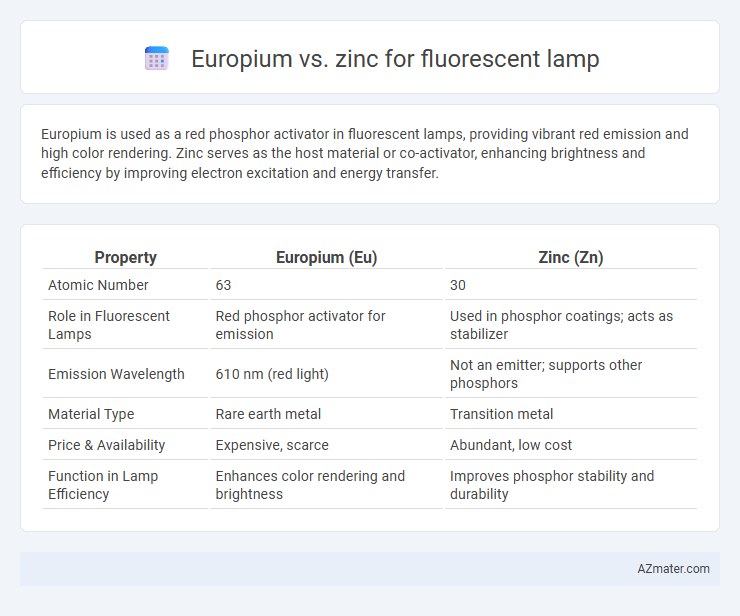Europium is used as a red phosphor activator in fluorescent lamps, providing vibrant red emission and high color rendering. Zinc serves as the host material or co-activator, enhancing brightness and efficiency by improving electron excitation and energy transfer.
Table of Comparison
| Property | Europium (Eu) | Zinc (Zn) |
|---|---|---|
| Atomic Number | 63 | 30 |
| Role in Fluorescent Lamps | Red phosphor activator for emission | Used in phosphor coatings; acts as stabilizer |
| Emission Wavelength | 610 nm (red light) | Not an emitter; supports other phosphors |
| Material Type | Rare earth metal | Transition metal |
| Price & Availability | Expensive, scarce | Abundant, low cost |
| Function in Lamp Efficiency | Enhances color rendering and brightness | Improves phosphor stability and durability |
Introduction to Fluorescent Lamps
Europium and zinc are critical components in fluorescent lamps, influencing light quality and efficiency. Europium serves as a red phosphor activator, enhancing color rendering by emitting bright red light, while zinc, often in the form of zinc sulfide, acts as a green phosphor, contributing to balanced color output. The combination of europium and zinc phosphors enables fluorescent lamps to produce a broad spectrum of visible light, improving energy efficiency and visual comfort compared to traditional incandescent bulbs.
Key Roles of Europium in Fluorescent Lighting
Europium plays a crucial role in fluorescent lighting by acting as a red phosphor activator, enhancing color rendering and brightness due to its sharp emission lines in the red spectrum. Zinc, often found in zinc oxide, primarily serves as a host lattice in phosphors and contributes to durability and energy efficiency but lacks the distinct color emission properties of europium. The unique electronic configuration of europium ions enables efficient energy transfer and luminescence, making it essential for producing vivid, high-quality light in fluorescent lamps.
Zinc’s Contribution to Fluorescent Lamp Technology
Zinc plays a crucial role in fluorescent lamp technology by enhancing the phosphor's efficiency and brightness through its incorporation in zinc oxide compounds, which improve light emission spectra. Unlike europium, which is primarily used as a red phosphor activator, zinc contributes to the overall stability and lifetime of the lamp by improving electron conductivity and reducing energy loss. The combination of zinc-based materials in fluorescent lamps leads to more energy-efficient and durable lighting solutions compared to those relying solely on europium.
Chemical Properties: Europium vs Zinc
Europium exhibits strong red and blue luminescence due to its unique electronic configuration and ability to emit sharp spectral lines, making it essential in fluorescent lamp phosphors. Zinc, by contrast, primarily acts as a stabilizer or activator in certain phosphor compounds but lacks the distinctive luminescent properties of europium. The chemical properties of europium, such as its variable oxidation states (Eu2+ and Eu3+), directly influence its luminescent efficiency, whereas zinc's stable +2 oxidation state contributes to structural integrity rather than light emission.
Efficiency and Brightness Comparison
Europium-doped phosphors in fluorescent lamps provide higher brightness levels and superior color rendering compared to zinc-based phosphors due to their sharp red emission lines, enhancing the overall luminous efficiency. Zinc phosphors, typically zinc sulfide or zinc oxide, offer moderate brightness but lower efficiency because their broader emission spectra reduce color purity and light output. The efficiency advantage of europium phosphors results in reduced energy consumption and longer lamp lifespan, making them the preferred choice for high-performance fluorescent lighting applications.
Color Rendering: Europium vs Zinc
Europium-doped phosphors in fluorescent lamps offer superior color rendering due to their ability to emit sharp red wavelengths, enhancing the lamp's overall color accuracy and warmth. Zinc-based phosphors tend to produce broader emission spectra, which can result in less vivid reds and a lower Color Rendering Index (CRI). As a result, europium-containing phosphors are preferred for applications demanding high-quality and natural lighting environments.
Environmental Impact and Safety Considerations
Europium, commonly used as a phosphor in fluorescent lamps, poses environmental concerns due to its rare earth element extraction, which can lead to habitat disruption and toxic waste. Zinc, often utilized in alternative phosphor compounds, offers a more sustainable profile with lower toxicity and easier recyclability, reducing environmental harm. Safety considerations favor zinc-based phosphors as they minimize the risk of hazardous material exposure during lamp manufacture and disposal.
Cost and Availability in the Lighting Industry
Europium, a rare earth element, is significantly more expensive and less abundant compared to zinc, impacting the overall cost of fluorescent lamps that rely on europium-based phosphors for red emissions. Zinc, commonly found in zinc oxide or zinc sulfide phosphors, offers a more cost-effective and widely available alternative in lighting applications, though it may not achieve the same color rendering quality as europium-based materials. In the lighting industry, the higher cost and limited supply of europium can result in increased manufacturing expenses and supply chain challenges relative to the more accessible and affordable zinc-based options.
Applications and Market Trends
Europium is primarily used as a red phosphor in fluorescent lamps, contributing to high color rendering and energy-efficient lighting solutions, especially in premium display and specialty lighting markets. Zinc compounds, such as zinc sulfide, serve as phosphors for green and blue emissions, widely applied in general lighting and backlighting applications due to cost-effectiveness and availability. Market trends indicate a growing demand for europium-based phosphors driven by advancements in energy-efficient and high-performance lighting technologies, while zinc-based phosphors maintain strong usage in conventional fluorescent lamp production.
Future Prospects: Advancements and Innovations
Europium's superior red phosphorescence in fluorescent lamps positions it as a key element for enhancing color rendering and energy efficiency in next-generation lighting technologies. Zinc-based phosphors offer cost-effective alternatives with promising improvements in durability and environmental impact, driving research into hybrid materials that combine the strengths of both elements. Ongoing advancements in nanotechnology and synthesis techniques are expected to optimize Europium-Zinc phosphor composites, paving the way for brighter, longer-lasting, and more sustainable fluorescent lighting solutions.

Infographic: Europium vs Zinc for Fluorescent lamp
 azmater.com
azmater.com